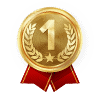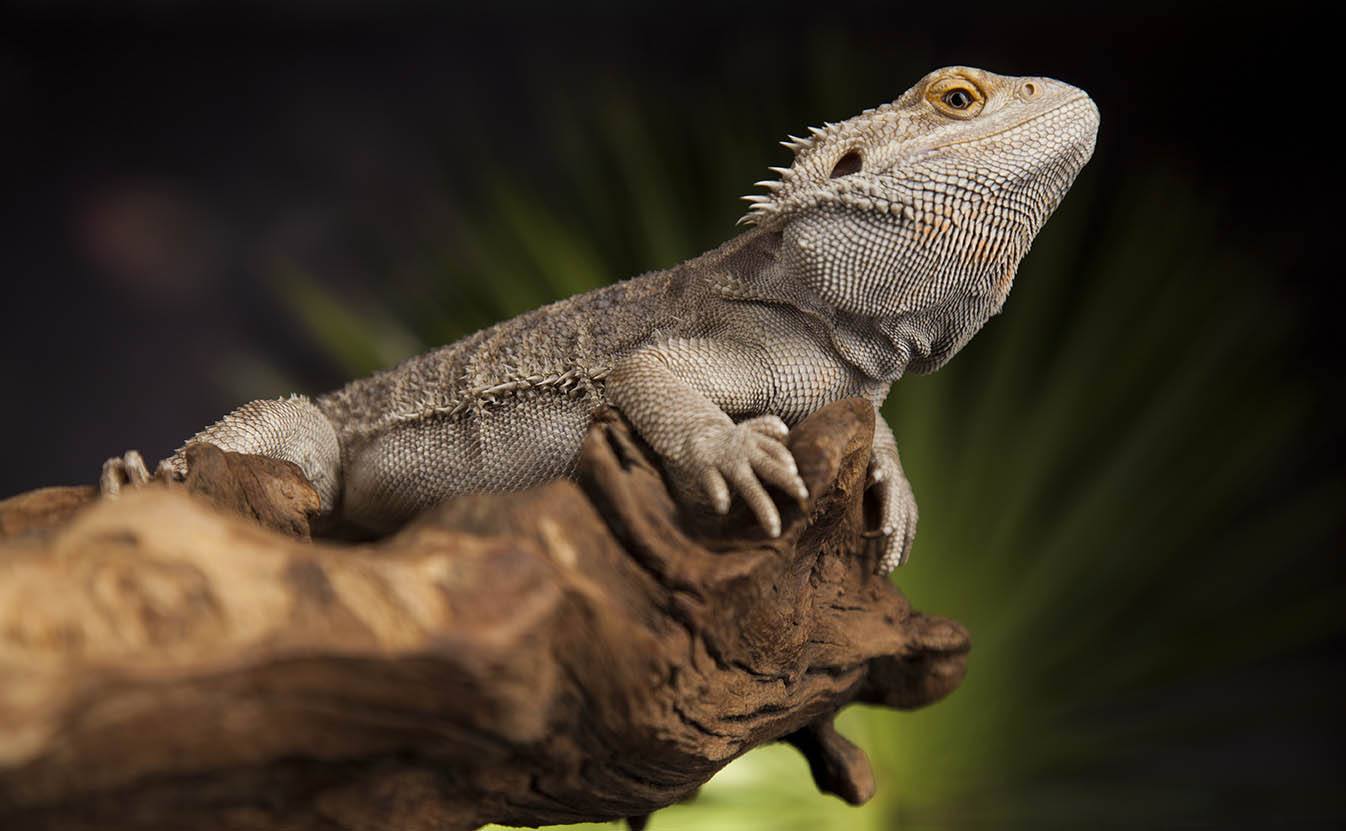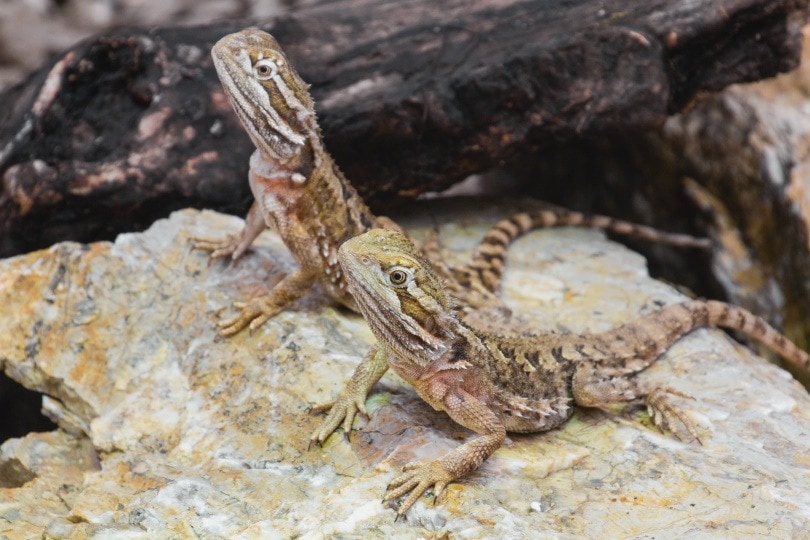Getting the right substrate for your Bearded Dragon is important. It needs to be comfortable enough for your Beardie to walk on, lay on, and generally live on. But it also needs to be safe, and the topic of which type of substrate is best is one that causes some debate. Some owners steer clear of loose substrates like wood chips because of the fear of impaction, while others point to the fact that these substrates are found in the reptile’s natural habitat. Similarly, there’s debate over the use of liners, but there are concerns that your Beardie’s nails can get caught in the fabric.
Whatever your preference of substrate, there are options available to you and, below, we have included reviews of 10 of the best beddings for Bearded Dragons to help you find the best for your vivarium.
A Quick Glance at Our Favorites (2024 Update)
| Image | Product | Details | ||
|---|---|---|---|---|
| Best Overall |

|
Zoo Med Premium Repti Bark Natural Fir |
|
Check Price |
| Best Value |

|
Zilla Terrarium Liner |
|
Check Price |
| Premium Choice |

|
Exoticare Desert Blend Reptile Substrate |
|
Check Price |

|
Zoo Med Eco Earth Loose Coconut |
|
Check Price | |

|
Zilla Ground English Walnut |
|
Check Price |
The 10 Best Beddings for Bearded Dragons
1. Zoo Med Premium Repti Bark Natural Fir Reptile Bedding – Best Overall
| Bedding Type: | Bark |
| Volume: | 4 Quarts |
Zoo Med Premium Repti Bark Natural Fir Reptile Bedding is made from fir tree bark. It absorbs moisture, which can make it difficult to maintain humidity levels. The bark consists of small chips, which means insects can’t easily hide in the substrate and your little one won’t have to hunt around the enclosure when it wants to eat. Zoo Med also claims that the bark is washable and can be reused, by soaking it in hot water every few months. The fir bark is comfortable for your Bearded Dragons to walk on and allows for easy burrowing and digging.
The natural odor of the fir does a decent job of controlling odors while the smaller size means that it spreads better than large bark shards, and it is reasonably priced especially considering it can be reused. It is our choice as the best overall bedding for Bearded Dragons. However, it hasn’t been heat treated which means that some bags have had mites in them, so you will need to check the substrate before use and potentially discard it. It’s not a common occurrence, but it can happen.
2. Zilla Terrarium Liner – Best Value
| Bedding Type: | Liner |
| Volume: | 40 Gallons |
Terrarium liner is considered a good alternative to loose substrates if your Bearded Dragon is prone to ingesting bits of bark and other materials. Roll the liner out, cut it to size, and that’s it. It is absorbent and the soft liner is comfortable to walk on, although the sharp claws of your Bearded Dragon may get caught in the liner so you will need to watch for that. The liner can be washed and reused: simply wash it in cold tap water to clean it and it’s ready to go again. Zilla treats its liners with a natural enzyme that helps cover up some of the smell that Beardie poop and wee produce.
Zilla Terrarium Liner works out very inexpensive because it can be washed and reused several times, although it will need replacing eventually, especially if your Beardie’s claws snag any holes. However, its low cost and low maintenance requirements make it the best bedding for Bearded Dragons for the money. You will need to buy a larger size than you think you need, though, as this allows for the variance in enclosure sizes and the required dimensions of the liner.
3. Exoticare Desert Blend Reptile Substrate – Premium Choice
| Bedding Type: | Natural |
| Volume: | 12 Pounds |
Exoticare Desert Blend Reptile Substrate is a mixture of various natural materials including coconut, sand, peat, and moss. It also has added calcium and comes in a handy resealable bag that makes it easy to store. It is an expensive substrate, but the mixture of natural materials means it is a premium substrate option that is safe if ingested, and the packaging means that it is easy to keep. Its soft, organic material makes it suitable for Beardies that love to dig.
This substrate is bioactive, containing moss and peat, which means that it will healthily support plants, growths, and essential microorganisms, and is very well suited to pets that come from arid regions.
4. Zoo Med Eco Earth Loose Coconut Fiber Reptile Substrate
| Bedding Type: | Coconut Fiber |
| Volume: | 8 Quarts |
Zoo Med Eco Earth Loose Coconut Fiber Reptile Substrate is made from coconut fibers which naturally break down odors and also allow for burrowing and digging. The substrate benefits from being kept damp, which means you will need to mist every day, but this will also help maintain necessary humidity levels and ensure that your Bearded Dragon has ideal environmental conditions. It can also be used in conjunction with other substrates to create a bioactive substrate that encourages plant growth.
Coconut fibers are considered an eco-friendly material, and the substrate is reasonably priced, although it can’t be washed and reused, which means the costs can add up, especially if you have a couple of Beardies sharing the same enclosure.
5. Zilla Ground English Walnut Shell Reptile Bedding
| Bedding Type: | Ground Walnut Shell |
| Volume: | 5 Quarts |
Zilla Ground English Walnut Shell Reptile Bedding is made from ground walnut shells, which is an environmentally friendly substrate because the shells are usually disposed of after the walnuts themselves are consumed. The ground shells have a natural appearance, and they won’t scratch the glass of the enclosure as sand does. And, because they are ground down, the substrate offers digging opportunities while retaining heat.
The bedding is reasonably priced and while a lot of owners are put off using walnut shells because they can be quite sharp, Zilla’s ground walnut shells are much smaller and finer, making them a reasonable option, but because the shells are ground so finely, the substrate can be a little dusty and may cause a mess in the enclosure.
6. Frisco Fir Bark Reptile Bedding
| Bedding Type: | Fir Bark |
| Volume: | 24 Quarts |
Frisco Fir Bark Reptile Bedding is made from the by-products of the timber industry, which means it is a sustainable solution. The fir bark itself is effective at retaining moisture, which means extra work is needed to maintain humidity levels. It is washed and sieved before packaging, which helps keep dust levels down, too, and the bark can be an effective tool when your Beardie is shedding because its texture helps naturally encourage a successful shed.
Frisco Fir Bark Reptile Bedding is reasonably priced and it comes in a large bag so you won’t need to buy regular refills. The bag is resealable, ensuring that the substrate retains its high quality between uses. The bark spreads out well, although there will be a little dust by the time you reach the bottom of the bag and fir bark isn’t the most popular option with all Beardie owners because it can dig into feet.
7. Zilla Lizard Litter Aspen Chip Reptile Bedding
| Bedding Type: | Aspen Chips |
| Volume: | 24 Quarts |
Zilla Lizard Litter Aspen Chip Reptile Bedding is another substrate that comes in a large, 24-quart bag. The wood has been heat-treated, which means it should be free from mites and also ensures that it is an absorbent substrate that will gather urine while making the spot cleaning of poop easy.
While the bedding is a really cheap price, and the bag is large enough to last for some time depending on the size of your tank and how generous you are, the bag isn’t easily resealed. Also, although the chips are easy enough to dig in, the hollowed-out burrows don’t really retain their shape, which means that any holes your Bearded Dragons dig will soon cave in.
8. Galapagos Tropicoco Husk Coconut Reptile Bedding
| Bedding Type: | Coconut Husk |
| Volume: | 8 Quarts |
Galapagos Tropicoco Husk Coconut Reptile Bedding is made from coconut husks that are washed and sieved before being compressed into a brick for easier shipping. The substrate is reasonably priced, and it is a highly absorbent bedding material that retains moisture.
Galapagos states that the bedding is dust free and free from salt, chemicals, and oil, as well as parasites. Although reasonably priced, the compressed brick can be difficult to break down and needs to be mixed with water before use. It takes a lot more effort than simply pouring loose substrate into the bottom of the enclosure.
9. Zoo Med Excavator Clay Burrowing Reptile Substrate
| Bedding Type: | Sand |
| Volume: | 10 Pounds |
Some Bearded Dragons love to dig and especially enjoy digging out their own burrow, although this isn’t true of all. Even if you provide caves and multiple areas of natural coverage, your Bearded Dragon may choose to burrow in its substrate rather than use these. In these cases, you need a substrate that is easy to dig but also that retains its shape once it has been dug. Some loose substrates simply collapse on themselves once dug, which renders them useless for this purpose.
Zoo Med Excavator Clay Burrowing Reptile Substrate can be laid as substrate and misted, which will enable your little lizard to dig and create burrows that hold their shape. Alternatively, you can wet the sand yourself and create tunnels and holes that will form a part of your Beardie’s enclosure habitat. The sand is natural and does not contain dye or other chemicals, and it is reasonably priced for a single bag, but you will need a lot of it if you intend to create your own masterpieces, which means it works out to be quite expensive. It also takes several days for the sand to dry and until this time, there is still a risk of it collapsing.
Also, it is difficult to clean because urine runs through, and poop can be difficult to find and remove.
10. Exo Terra Equatorial Forest Floor Reptile Substrate
| Bedding Type: | Combination |
| Volume: | 4 Quarts |
Most reptiles live in areas with a floor substrate that is somewhat mixed, such as leaves and foliage on top of a soil floor. Exo Terra Equatorial Forest Floor Reptile Substrate aims to mimic this multi-layer floor by offering multiple substrates. It includes coconut husk fiber, which acts as a base layer, and Ardisia leaves that sit on top. All Bearded Dragons originate from Australia, and some do naturally live in subtropical woodlands which means they would naturally live on a floor with this base layer combined with a leafy top layer.
From a practical point of view, however, leaves can make it easy for insects to hide and difficult for you to clean. Also, it does work out as quite an expensive substrate.
Buyer’s Guide: Selecting the Best Bearded Dragon Substrate & Bedding
Getting the right substrate, or bedding, for your Bearded Dragon not only ensures that your Beardie is comfortable but also helps with managing temperature and humidity levels. Beardies originate in Australia where they live in arid conditions in the desert and subtropical wooded areas. This range of different natural habitats means that Beardies can have different types of substrate in their enclosures, too. You can even use household items like paper towels and at a push, newspaper.
Below, we look at some of the most common Bearded Dragon beddings to help you decide which is best for your lizard friend.

Substrate Type
There are many options when it comes to the type of substrate suitable for Bearded Dragons. Although they all originate from Australia, there are a lot of different types of habitats ranging from the Western Desert to the dry forests of the North. These different habitats have different substrates, which means there is an equally diverse range of commercially available beddings, as well as some materials you likely have laying around the house already.
What Do Bearded Dragons Sleep In?
Bearded Dragons sleep during the night, typically with their enclosure lights turned off, and laying down. This means that you should have the lights in your Beardie’s enclosure on a timer so that they turn off at bedtime and back on again in the morning. They need some heat, but the tank should not be as hot at night as it is during the day. Whilst they typically sleep laid down, they may also sleep vertically, up against the corner of the cage, or up a log or tree.
They do sleep up to 12 hours every 24 hours, and yours may sleep in a hide, under a log, in a corner, or it may even attempt to dig a hole to sleep in.
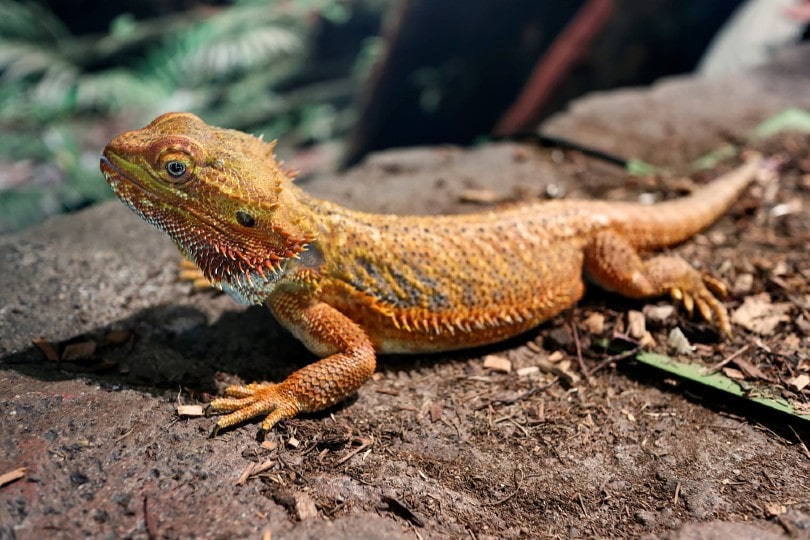
How Big an Enclosure Does a Bearded Dragon Need?
Generally, it is recommended that a single adult Bearded Dragon is given a tank with at least a 40-gallon capacity. There is no such thing as too much room, so you can provide much more space than this if you want. Although they prefer mostly vertical space, Beardies also like to climb and they will need a basking spot that is generally higher than the rest of the enclosure, so the tank will need some height to it.
What Else Should Go in a Bearded Dragon Enclosure?
The aim, when setting up a Bearded Dragon enclosure, is to replicate as much of the Beardie’s natural living conditions as possible. As well as the tank itself, and substrate to cover the bottom, you will need a UVB light and heating elements. You will also need thermometers and hygrometers. A basking spot can consist of a rock or log placed under a heat lamp, and you should provide some hides, foliage, and other decorations for the tank. You will need a food bowl, and something to provide drinking water.
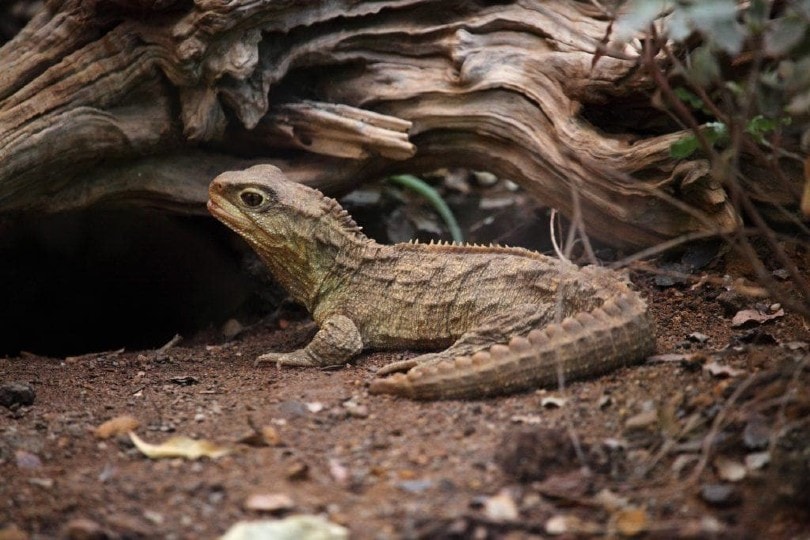
Conclusion
Bearded Dragons make great pets. They tend to be awake during the day, which means that you can watch them go about their business. They usually take well to being handled, with experience and care, and are considered one of the easier reptiles to care for. However, you do need to ensure that you provide a suitable enclosure, ensuring that it is not only the right size but meets your Beardie’s other physical and living requirements.
While compiling the reviews above, we found the Zoo Med Premium Repti Bark Natural Fir Reptile Bedding to be good value for money, especially because it can be cleaned and reused. Zilla Terrarium Liner is a good option for those that want a fully reusable substrate and one that is soft and gentle on Bearded Dragons’ feet and bellies.
Featured Image Credit: zoosnow, Pixabay



